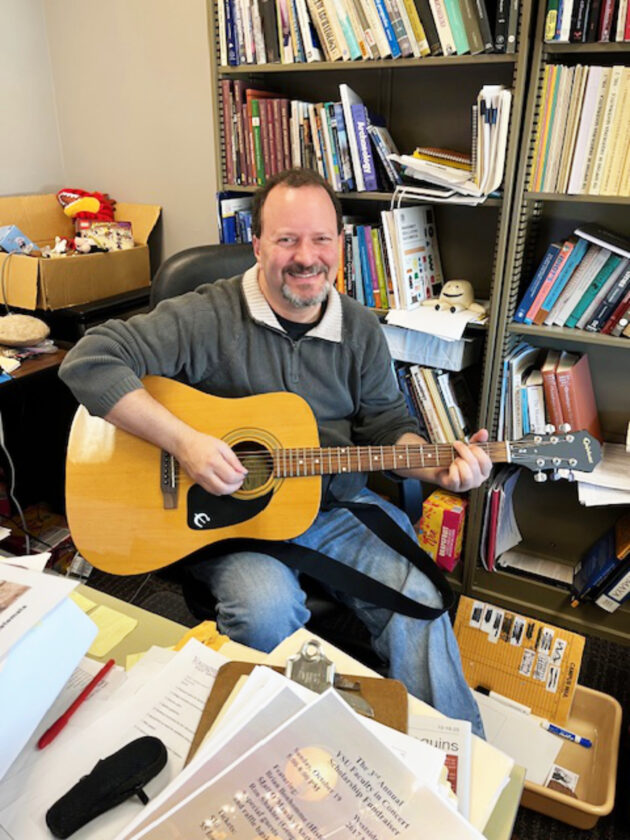Half Indiana Jones, half Tom Waits
YSU archaeologist moonlighting as a musician

Correspondent photo / Maurita Hoffman Matt O’Mansky, professor of anthropology and archaeology at Youngstown State University, shows off his strumming skills in his DeBartolo Hall office. His foster kittens sometime join him there. He plays often with other Youngstown State professors during charity and scholarship fundraisers.
Some people have a moment when they know what they want to do with their lives. So it was for Matt O’Mansky.
When he was 10 years old, he saw a display for King Tutankhamun, the boy king of ancient Egypt, at the Smithsonian Institute in Washington, D.C. From this first viewing, he knew what he wanted to do.
“I was fascinated,” O’Mansky said. “King Tut’s display was amazing, and I wanted to find out how the archaeologists found these things.”
O’Mansky, now 57, has been a professor of archaeology and anthropology at Youngstown State University since 2005. He is currently the coordinator of the Anthropology and Sociology Department.
O’Mansky grew up in Baltimore. During high school, he spent his junior year abroad as an exchange student in Finland. He went on to earn his bachelor’s degree from Indiana University and his doctorate at Vanderbilt University.
After his acceptance into the ultracompetitive Vanderbilt program, one of his professors informed him that his international study experience had aided in his acceptance into the doctorate program in anthropology / archaeology. As an instructor today, he tells his students to broaden their experiences and to travel.
“You never know when that experience is going to help you,” he said. “You never know who you are going to meet because of that trip.” He added the importance of “becoming a citizen of the world.”
O’Mansky teaches several anthropology classes but his focus is in archaeology and the Mayan civilization, which once occupied an area that today comprises southeastern Mexico, all of Guatemala and Belize, and the western portions of Honduras and El Salvador.
He fell into Mayan studies during his years in college. While studying at Indiana University, he spent three months in Belize.
“I loved it, everything about it,” he said.
Then, during graduate school at Vanderbilt, he took his first trip to Guatemala, and he “fell in love with it — the land, the people, the work.”
When he then began working in Guatemala, the people living there were wary of him and his team.
“They live in the jungle; it is very remote,” he said. “The villagers initially thought we were there to steal from them — either buried treasures or anthropological finds. They even thought that perhaps we were from the government and did not trust us.”
O’Mansky pointed out that these villages are isolated and extremely poor.
There is limited water and there are no jobs, so O’Mansky and his team “would hire some of the villagers to help with the expedition.”
The teams also sent doctors into the villages. He said once the people realized the archaeologists meant them no harm and were not there to take advantage of them, it became easier to work there.
Over the years, O’Mansky said he has become friends with some of the villagers and is happy to meet up with them on return trips.
Now, as a professor,O’Mansky takes students to Guatemala every few years.
The trips last 10 to 12 days during spring break. He said the students are a little hesitant at first, but “become passionate and enthusiastic when they see things they never thought they would see.”
The areas where O’Mansky usually travels to are in the northern part of the country — the jungle. This part of Guatemala, he said, is “hot, muggy, buggy, and there are lots of snakes.”
He noted that most of the snakes are harmless, “but not all of them.”
Some of the trips O’Mansky and his students take are to the southern portion of the country — the highlands, with its temperate mountain climate and lack of bugs. He admitted that as he has gotten older, this part of the country holds more appeal to him.
Not all O’Mansky’s work is in the classroom or in Central America. He said the department has been called upon by local organizations and municipalities to check specific areas. He took a ground penetrating radar machine to Pioneer Cemetery in Trumbull County to see if there were unmarked graves. His team has been called to check for unmarked graves at proposed building sites. And he’s been asked to determine whether certain mounds in fields are natural or manmade.
He has other interests as well, ones that don’t involve digging in the dirt — like cats. He has lots of cats. He is on the board of West Side Cats, a no kill rescue and adoption center in Youngstown, and he has been fostering cats since 2017. Stop by his office in DeBartolo Hall and there’s a chance you may see a kitten romping about. He noted his mother loves cats and her home in Baltimore is sometimes called “Camp O’Mansky.”
O’Mansky is also a musician. He played the tuba in high school and was “quite good,” he said, making the all-state band.
He added that he “briefly took guitar lessons in fourth grade, but I really started playing the guitar when I was 20 years old.”
Now, he often plays the guitar and sings at musical fundraisers, many times held at Westside Bowl with other YSU professors.
Often, he’s raising money for the Meghan Galloway Scholarship for Anthropology. Galloway was a student of his who passed away in 2017.
